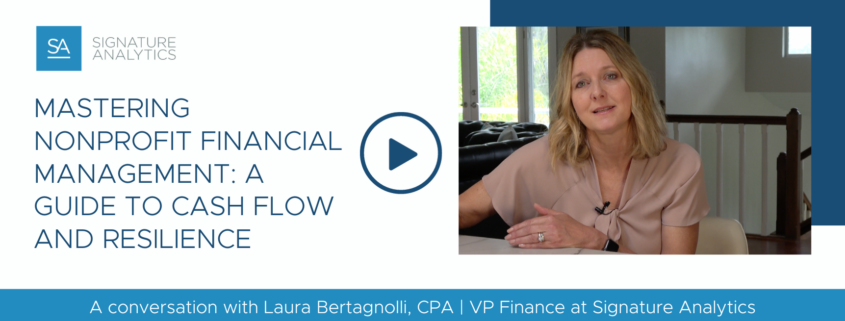Mastering Nonprofit Financial Management: A Guide to Cash Flow and Resilience
In nonprofit financial management, ensuring long-term stability and resilience is crucial. It’s not just about crunching numbers; it’s about understanding the intricate dynamics of cash flow and incorporating that understanding into your financial planning.
In the video below, Laura Bertagnolli, CPA, discusses why cash flow management is essential for nonprofit organizations.
Why Managing Cash Flow is Important for Nonprofit Organizations
Nonprofit organizations have a unique set of financial challenges compared to their for-profit counterparts. While their primary mission is to serve their communities and further their charitable objectives, they must also ensure financial sustainability. One of the fundamental pillars of financial sustainability for nonprofits is effective cash flow management.
Sustainability and Mission Continuity: The lifeblood of any nonprofit organization is its ability to carry out its mission effectively. A steady cash flow is essential to cover operational costs, pay staff, and fund essential programs and services. Without proper cash flow management, nonprofits risk interruptions in their operations, which can impede their ability to make a positive impact in their communities.
Budget Variability: Nonprofit funding often comes from a mix of sources, including grants, donations, and program fees. These funding sources can vary in timing and amount. Effective cash flow management helps nonprofits align their budgets with the actual cash they expect to receive, reducing the risk of budget shortfalls and financial strain.
Financial Planning and Forecasting: By incorporating cash flow management into their financial practices, nonprofits gain a clearer understanding of their financial health. This knowledge empowers them to plan for the future more effectively, anticipate challenges, and seize opportunities.
Contingency Planning: Nonprofits face external factors, such as economic downturns or unforeseen emergencies, that can affect their financial stability. Managing cash flow allows organizations to establish contingency plans and build financial reserves to weather unexpected challenges.
Credibility and Stakeholder Trust: Nonprofits are accountable to their donors, grantors, and the communities they serve. Demonstrating strong cash flow management and financial transparency enhances credibility and fosters trust among stakeholders. It reassures them that their contributions are being used effectively and sustainably.
Leveraging Opportunities: Cash flow management enables nonprofits to seize strategic opportunities as they arise. Whether it’s scaling successful programs, embarking on new initiatives, or making strategic investments, having a clear picture of available funds is essential for growth.
Strategic Decision-Making: Nonprofits that effectively manage cash flow are better positioned to make strategic decisions. They can allocate resources strategically, prioritize projects, and navigate financial challenges more effectively, ultimately advancing their mission.
“Nonprofits need to include a 12-month cash roll-forward to incorporate capital expenditures [and] any assumptions within the budget that give a different picture of the organization’s financial stability…. In fact, if you get to the point where you’re concerned really about what your cash flow is going to be, even over the next quarter, you’d want to institute a 13-week cash flow forecast, which is more in-depth.”
The Value of a 13-Week Cash Flow Forecast
A 13-week cash flow forecast is like a detailed financial map for nonprofit organizations. It offers several benefits:
Detailed Insights: Instead of a big picture, it provides a close-up view of finances over a quarter (13 weeks). This helps organizations see when money comes in and goes out in detail.
Early Problem-Solving: By looking ahead for 13 weeks, nonprofits can spot money problems early. This means they can fix things before they become big issues.
Cash Planning: The forecast helps nonprofits plan how they spend their money. It ensures they have enough for important things like salaries and bills.
Prepare for Emergencies: Nonprofits can use this forecast to make backup plans for unexpected money troubles. It’s like having an emergency fund for their budget.
Grant and Project Management: For nonprofits getting money from grants or events, the forecast helps them match when they get the money to when they need it for specific projects.
Smart Decisions: With a 13-week forecast, nonprofit leaders can make wise choices about starting new projects, expanding, or making other decisions that need money.
Cash Flow and Development Planning
Cash flow management plays a pivotal role in shaping the strategies of nonprofit organizations.
Here’s how cash flow relates to development planning and why it’s a crucial aspect for nonprofit success:
Strategic Alignment: Nonprofits often set goals for program development, fundraising campaigns, and community outreach. Effective development planning relies on knowing when funds will be available. Cash flow management ensures financial resources are in sync with these strategic plans.
Program Expansion: For nonprofits looking to expand or launch new initiatives, understanding cash flow is essential. It helps identify periods when funds might be tight or abundant, allowing organizations to time their expansions effectively.
Fundraising Timing: Nonprofits frequently rely on fundraising efforts to support their programs. Cash flow insights help in choosing the right times for fundraising campaigns, ensuring that funds are available for immediate use when the donations come in.
Budget Adjustments: As the fiscal year progresses, cash flow analysis reveals whether an organization is on track with its budget or if adjustments are needed. This adaptability is key for making informed decisions and preventing financial shortfalls.
Mitigating Constraints: By closely monitoring cash flow, nonprofits can identify potential constraints in advance and take steps to address them. This proactive approach minimizes disruptions in program delivery.
Optimizing Giving Times: Nonprofits can strategically plan their fundraising campaigns during periods when giving tends to be higher. This approach fills in cash flow gaps and ensures stable funding.
In summary, cash flow management isn’t just about tracking dollars in and out; it’s a tool that empowers nonprofits to align their development plans with their financial capabilities. By utilizing cash flow insights, organizations can make strategic decisions, adjust their budgets, and ensure that they have the financial capacity to achieve their mission and expand their impact in the community.
Common Mistakes in Nonprofit Financial Management
Nonprofit financial management is a delicate balancing act, and while adopting best practices is crucial, it’s equally important to avoid common pitfalls that can hinder an organization’s financial health. Here, we’ll explore some of the prevalent mistakes in nonprofit financial management that nonprofits should be aware of.
“Mistakes made when nonprofits only look at the statement of activities, the 12 months that you planned on the budget, and not really doing the hard work to project out cash.”
Overlooking Cash Flow: One of the most common mistakes is focusing solely on the statement of activities and the annual budget while neglecting detailed cash flow management. Failure to project cash flow accurately can lead to unexpected shortfalls and financial stress.
Budget Rigidity: Nonprofits that adhere too strictly to their annual budget may find it challenging to adapt to changing circumstances. Budgets should be flexible enough to accommodate unforeseen expenses or revenue fluctuations.
Ignoring Reserves: Some nonprofits fail to establish and maintain adequate reserves. Without a financial safety net, organizations may struggle to navigate financial crises, resulting in compromised program delivery.
Insufficient Planning: Inadequate financial planning and forecasting can leave nonprofits ill-prepared to meet their obligations, pay staff, or seize strategic opportunities. Accurate and proactive financial planning is essential for sustainable operations.
Lack of Transparency: Failing to maintain financial transparency can erode stakeholder trust. Nonprofits must provide clear and comprehensive financial reporting to donors, grantors, and the community to maintain their credibility.
Misaligned Fundraising Efforts: Timing is crucial in fundraising. Not coordinating fundraising campaigns with the organization’s cash flow needs can lead to temporary imbalances and funding gaps.
Failure to Monitor Key Performance Indicators: Without effective key performance indicators (KPIs) and regular monitoring, nonprofits may miss early warning signs of financial challenges. It’s essential to have KPIs in place to track the organization’s financial health and performance.
Inadequate Financial Oversight: Nonprofits may lack the necessary financial expertise within their leadership or board. Proper financial oversight and governance are vital to ensure that financial management is effective and compliant with regulations.
How Signature Analytics Can Help Your Nonprofit
Signature Analytics’ nonprofit accounting services help you make financial decisions based on the highest quality accounting practices, while our day-to-day outsourced accounting teams implement the highest quality donor and government accounting standards.
For additional assistance with cash flow management, developing detailed nonprofit budgets, and audit support, contact Signature Analytics today.





